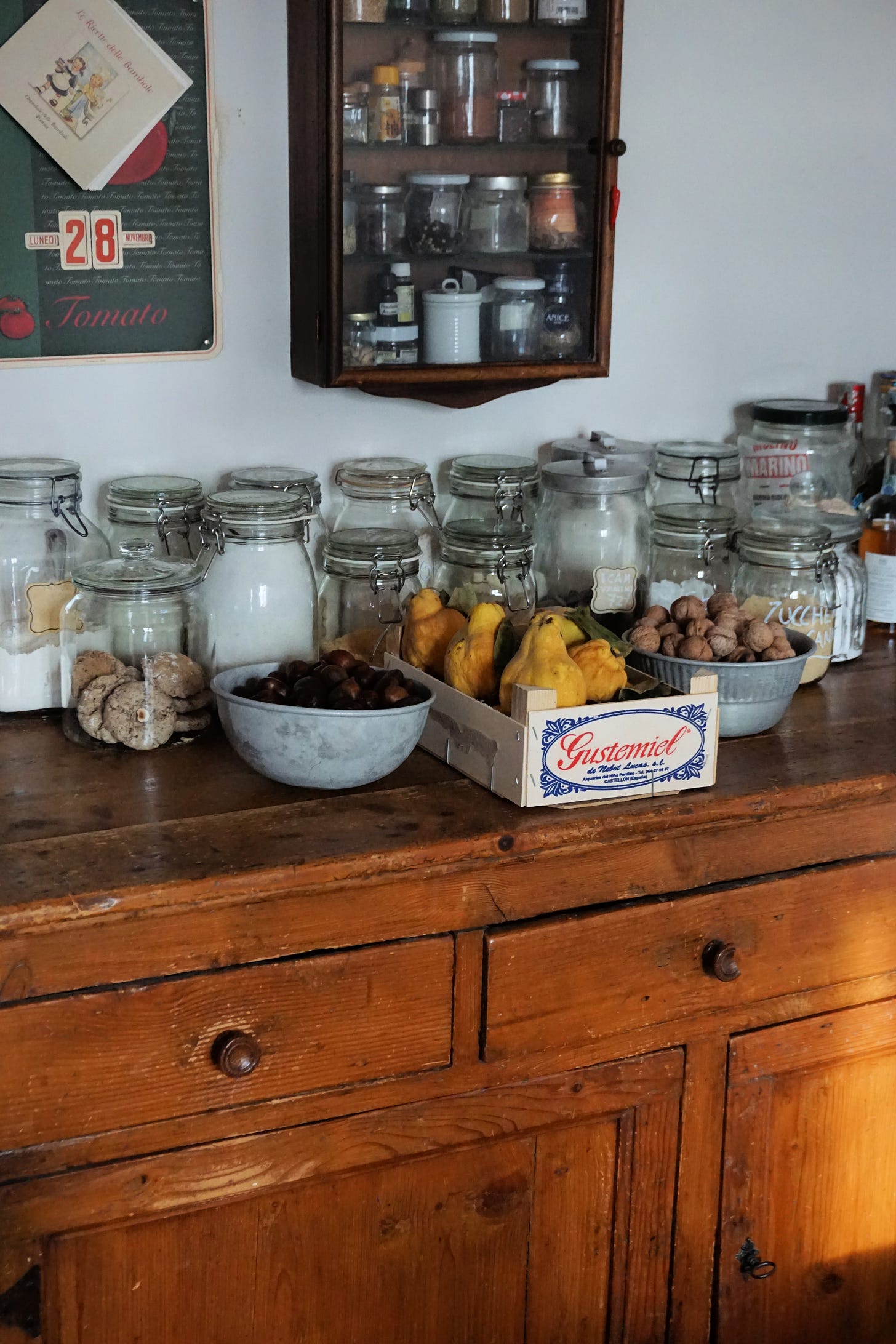Q&A with Emanuela Regi. Other people's pantries
A pastry chef from Pistoia with her heart in Paris | Her online pastry classes | Her recipe for dried fruit and chocolate cookies
Other people’s pantries is a series of Q&A with a focus on pantries as a privileged way to get into people’s lives, cooking styles, and favourite recipes. It is also an opportunity to chat with professionals I admire, and with friends with whom I have shared an important part of my personal and professional growth. You can read all the previous interviews here.
Today we have a chat with Emanuela Regi, a pastry chef with a suitcase, as she likes to describe herself. She is constantly divided between in-person and online learning courses - both for beginners and for more experienced ones -, the production of cookies, cakes, and croissants for restaurants and cafés, and continuous training, with frequent Parisian escapes. But I should start by saying that Emanuela is also one of my dearest friends. We met almost fifteen years ago thanks to our blogs and shared passion for food.
Emanuela made the cake and dessert buffet at our wedding and for Livia's baptism; she helped me prepare a stash of puff pastry and croissants when, nine-month pregnant, I wanted to fill the freezer with good things; she helped us test, and perfect, the dessert recipes that will appear in our next cookbook. In short, even if she were not one of my dearest friends, I would have endless reasons to love her and admire everything she does. She radiates calm and kindness, both when she is teaching how to roll a killer puff pastry or when sitting in front of a cup of tea (Earl Grey rooibos for us), she listens to all your hopes, concerns and ideas.
And it is precisely this calm and composure that, during her classes, makes everyone feel at ease, able to make a flaky croissant, a crostata, or a choux craquelin (Tommaso's passion).
Today we chatted about ingredients, pantries, and pastries.
Follow Emanuela on Instagram: @ladolcepeonia and on her websites, where she shares her recipes and the dates of her next in-person and on line classes (in Italian): ladolcepeonia.com
Part of our conversation is paywalled, and the subscribers will find Emanuela’s recipe for her very simple cookies, which require no special equipment or ingredients from the refrigerator and can be customized by combining the nuts you prefer (or have in the pantry) with chocolate.
When you join our subscription-based newsletter, you are actively contributing to the making of Letters from Tuscany.
Ciao Emanuela, can you briefly introduce yourself?
I am a pastry chef who came to this profession after scientific studies (I have a degree in forestry with a specialization in garden architecture and landscape design), seemingly by chance. I loved baking, and through a series of fortunate encounters and choices, I had the opportunity to explore pastry and realize that it was the job for me. I used to have a small pastry workshop in my hometown, Pistoia, but for the past 10 years, I have been working in other people's kitchens, collaborating with a social cooperative on projects involving pastry and baking workshops, and teaching classes for private individuals.
What is your relationship with the pantry? and what has been the role of the pantry in your family?
The pantry is an essential part of my kitchen (I dream of owning a pantry room), the source of inspiration both for pastry preparations (recipes that I have to test or create for classes) and for everyday cooking, which is very simple and often based on the few ingredients that are always present.
In my family, the pantry was a place that I discovered and appreciated mostly thanks to my grandmothers, while at home with my parents it was not such a special or important "place."
This is the first time we have a pastry chef in this column. What ingredients should be in your pantry to always be ready to tackle the basics of pastry making?
In the pantry you should always keep at least two different types of flour,- a weak one (with a low content of gluten) that you can use for most pastries, and a strong one (with a higher content of gluten) for leavened and puff pastries-, and sugars. In the refrigerator be sure to have eggs, butter and milk. With these ingredients, you could virtually prepare all pastry bases. To enrich them, consider storing chocolate, nuts, and invaluable aromas (spices and fresh citrus zest).
You were born and raised in Pistoia. How would you describe your town and its cuisine?
I was actually born in Prato (not far from Pistoia), but I have always lived in Pistoia (where we moved because of my parents' jobs, as neither of them was from Pistoia). Pistoia is a quiet provincial town, very livable, which can be easily explored on foot, and has a very beautiful historic centre. It has a typical Tuscan cuisine, with many dishes in common with other neighbouring towns and some very typical ones linked mainly to festivities.
What are the ingredients that characterise a classic Pistoiese larder?
Although my family is not from Pistoia, I would undoubtedly say polenta flour and chestnut flour (a very important ingredient in our mountain cuisine), seasonal vegetables (Tuscan kale in winter and snake beans in summer), bottled tomato sauce, ricotta cheese, and pecorino cheese.
When you are at home, where do you usually do your shopping? Can you recommend your favourite shop in Pistoia?
Besides a favourite supermarket, I buy some ingredients through a local Gas1, in organic markets or from some producers. Two shops I really like are the Mona Verde farm shop (here in Pistoia) and the shop of La Caciosteria (in Pavana) for cheeses, special flours, and high-quality products I cannot find elsewhere.
You have a passion for French pastry, what fascinates you and which of its ingredients are a constant in your pantry?
French confectionery art is creative and innovative: they love and alter the classics while respecting them and making great use of seasonal ingredients. I really like the fact that it follows an annual trend not only related to holidays but also to seasonal ingredients. This also brings a great use of fruit (both fresh and dried) in its pastries.
Some of the ingredients that periodically pass through my pantry (especially after trips to Paris) are praline (which I have recently started making myself), feuilletine, and chopped cocoa beans.
What is the difference between the Italian province and Paris when it comes to sourcing pastry ingredients? I think of supermarkets, markets, small neighbourhood shops, online shops...
Here in Pistoia, we have a wholesale of products for bakeries and pastry shops that has also been selling retail for some years, so in general, I can find most of the ingredients. Otherwise, I rely on online shops for some specific products, like flour, spices, and chocolate. On the other hand, there are no more small shops (either for ingredients or equipment) for which you have to go to Florence.
How much is your pastry influenced by the pantry and how much by the seasons or occasions?
I would say mainly by the seasons, as I tend to use specific fruit, flours or ingredients more suited to certain times of the year. The pantry constitutes a base that is then supplemented during the year with more seasonal products.
After the pandemic, your offer has expanded to include highly successful online courses: not only those on the basics of pastry making but also those on Sunday cakes. What are your upcoming online courses?
Speaking of French pastry, in December the two Sunday cakes will be the Mont Blanc (in a tarte version) and the galette des Rois (one of those classics that fill the windows of boulangeries throughout January, in Paris) and the third course will be very Christmasy, dedicated to the unfailing cookies to give as gifts. [You can find all of Emanuela's courses on her website, they are in Italian, but if you are able to understand they are highly and sincerely recommended].
Can you recommend a book for learning the basics of Italian confectionery art?
Since we are talking about ingredients, rather than a recipe book (although there are recipes in this book, too) I would recommend a book whose aim is to scientifically explain how the ingredients function within a dough. It is La scienza della pasticceria by Dario Bressanini. It is a book that allows you to understand ingredients and techniques and thus approach the basics in a more conscious way. [The book is just in Italian but, again, if you can read Italian, it is highly recommended]
Last question! Can you share a sweet recipe to make with pantry ingredients?
What I love to make most (both at home and at work) are definitely cookies. These are very simple cookies, which require no special equipment or ingredients from the refrigerator and can be customized by combining the nuts you prefer (or have in the pantry) with chocolate. They are perfect for breakfast.







